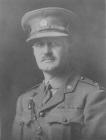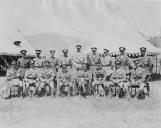1
03) Interwar Years 1919 -1939- Name changes
- The King's Colours
- The Whizzbang's Association
- Funding restrictions
- Relocations
- Equipment
- BC Dragoons
- Cavalry training in a changing world
- Kelowna's "temporary" armoury
- Summer camps
2
Members of the 2nd CMRs at the presentation of their battle honours.January, 1919
Bramshott, England, UK

4
In April of 1919, upon its return to BC, the 2nd CMRs were formally demobilized and the battle honours were transferred to the existing 30th BCH and the Victoria Independent Squadron of Horse militia units. Together they became the 1st Regiment, BC Mounted Rifles (BCMRs) in 1920 to be based in the Okanagan.The original King's Colours and Wreath, following the Infantry traditions for battle honours, were presented to the 2nd CMRs in Victoria. With the change in organization, the Colours were dedicated in Vernon and laid up at the All Saint's Anglican church. Tragically, this church burned to the ground a few years later along with the Colours. Only the metal wreath and a heavily buillion embroidered badge survived.
8
It was during the interwar period that the veteran's of the 2nd CMRs formed an association called the "Whizzbang's" in honour of the regiment's wartime commander, Lt. Col. G. C. "Whizzbang" Johnston DSO, MC. It was his diary which became the basis for the unit's history, the "2nd Canadian Mounted Rifles (British Columbia Horse) in France and Flanders" published by the association in 1932.Four years of total war had left more than 60,000 Canadian dead in military cemetaries in France and Flanders. True, the Canadian Corps, a volunteer army, had honoured itself beyond expectation throughtout the conflict, but the sacrifice in lives, the unromantic squalor of trench warfare had engendered in many people a permanent aversion to war. Popular sentiment during the 1920s and 1930s was therefore, decidedly pacifist. Government cuts in expenditures reflected that prevailing attitude.
10
The success of the unit again depended in large measure on local initiative and self-help. Officers regularily bought their own uniforms and kit. Frequently, all ranks would donate their pay for the service in the regiment to a fund set up to purchase uniforms or pay rent on the drill hall. Once again, the unit relied on parades, athletic events and social affairs to raise funds and encourage recruiting. These methods worked tolerably well during the properous years of the 1920s but after the Depression began in 1929 the funds declined markedly.13
Lack of money affected the BCMRs in a variety of ways. For much of the interwar years Regimental Headquarters (RHQ) and 'A' squadron remained in Vernon, with 'B' squadron in Kelowna and 'C' squadron in Penticton. Of these, only Vernon had a proper armoury. In Penticton, 'C' squadron rented the Badminton Club (used by several Cadet Corps until recently), and parts of the local arena. For many years, 'B' squadron used a small room above a bakery shop and later the upper floor of a garage and funeral parlour, for offices and training.Equipment remained the WW I surplus kit until 1939. However, there was no return to the scarlet tunics and buff breeches worn by the old 30th BCH. Instead, the khaki field service uniform worn by Canadian cavalry units of WW I were retained, along with the rifles and bayonets. Defence regulations provided that not everyone would receive uniforms, equipment, or pay to attend summer camps.







